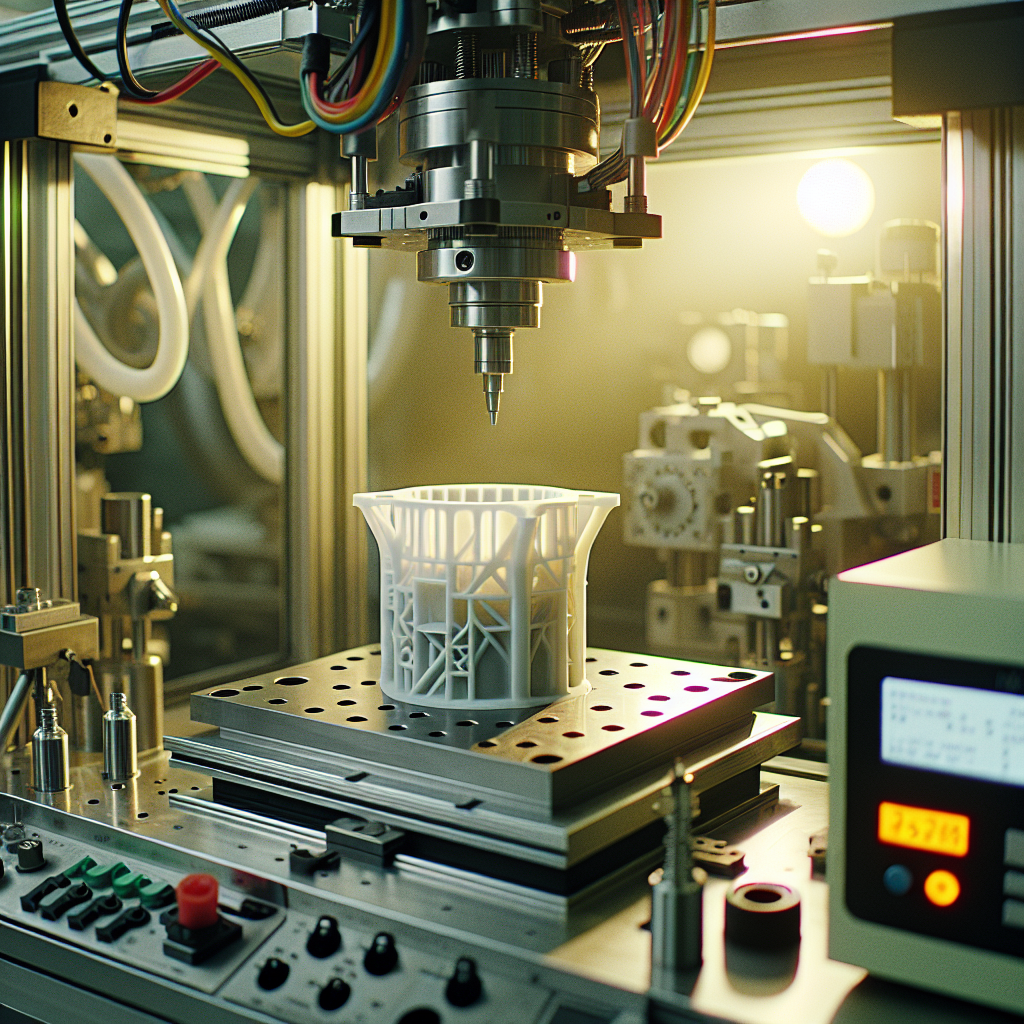In today's fast-paced and rapidly changing world, it is more important than ever to stay up-to-date with the latest innovations in wood manufacturing. The industry is constantly evolving, with new technologies and techniques emerging all the time.
Keeping up with these changes can be a daunting task, but failing to do so can put a company at a significant disadvantage.
The use of automation and robotics in wood manufacturing is expected to increase significantly in the coming years, with a projected CAGR of 7.5% from 2021 to 2026. (Source: Mordor Intelligence)
By staying ahead of the curve and adopting new innovations, wood manufacturers can improve their efficiency, productivity, and product quality, while reducing waste and their environmental impact. However, with so many new innovations being introduced, it can be challenging to know where to start.

In this article, we will explore the latest trends in wood manufacturing and discuss the advantages and challenges of adopting new innovations. We will also provide strategies for staying up-to-date with the latest developments, so that companies can remain competitive and successful in this ever-changing industry.
- Importance of Innovation in Wood Manufacturing
- Latest Innovations in Wood Manufacturing
- Technologies Driving Innovation in Wood Manufacturing
- Benefits of Adopting the Latest Innovations in Wood Manufacturing
- Challenges of Adopting the Latest Innovations in Wood Manufacturing
- How can MRP and ERP Systems Aid in Keeping Up with the Innovations in Wood Manufacturing?
- How can Deskera Help You?
- Key Takeaways
- Related Articles
Importance of Innovation in Wood Manufacturing
Innovation is crucial for the wood manufacturing industry, as it allows companies to improve their processes, reduce costs, and remain competitive in a constantly evolving marketplace. One of the most significant benefits of innovation is increased efficiency and productivity.
New technologies, such as advanced sawmill equipment and automated manufacturing systems, can help companies produce more products in less time, with fewer resources and less waste. This leads to reduced operating costs and higher profits.
Innovation can also help companies improve the quality and consistency of their products, which is critical in meeting customer demands and maintaining a strong reputation in the industry. By developing new techniques and products, companies can differentiate themselves from competitors and create a unique selling proposition.
Another important aspect of innovation in wood manufacturing is its potential to reduce environmental impact. New technologies can help companies reduce their energy consumption, waste generation, and carbon footprint, making their operations more sustainable and socially responsible.
In summary, innovation is essential for wood manufacturers to maintain their competitiveness and improve their profitability. It allows companies to produce higher quality products, reduce costs, increase productivity, and reduce their environmental impact. By keeping up with the latest innovations in the industry, companies can position themselves for success in a rapidly changing marketplace.
Innovation for Increased Efficiency and Cost Savings
Innovation can lead to increased efficiency and cost savings in wood manufacturing in several ways:
- Advanced technologies: New technologies such as computer-controlled sawmills and automated machinery can significantly improve the efficiency of wood manufacturing operations. These technologies can perform tasks quickly, accurately, and consistently, resulting in reduced labor costs and improved productivity.
- Process improvement: Innovation can help companies identify areas for process improvement, leading to increased efficiency and cost savings. For example, implementing lean manufacturing practices can reduce waste, improve process flow, and optimize resource utilization.
- Waste reduction: Innovations such as biomass utilization can help reduce waste and convert it into valuable resources, such as energy or raw materials. This can lead to cost savings and a reduced environmental impact.
Innovation can also lead to improved product quality in several ways:
- New materials: Innovation can help manufacturers identify and develop new materials with superior properties, such as strength, durability, and resistance to pests and moisture. These materials can improve the quality and longevity of wood products.
- Precision manufacturing: New technologies can help manufacturers produce wood products with greater precision and accuracy, resulting in higher quality products that meet or exceed customer expectations.
- Enhanced design: Innovation can lead to the development of new and innovative product designs that are more functional, aesthetically pleasing, and appealing to customers. This can improve the overall quality and value of wood products.
Latest Innovations in Wood Manufacturing
Wood manufacturing is an industry that has seen significant changes in recent years, with new technologies and innovative practices transforming the way wood products are produced. In this section, we will explore some of the latest innovations in wood manufacturing, from advanced sawmill equipment to digital manufacturing systems.
We will discuss how these innovations are improving efficiency, reducing costs, and enhancing product quality, as well as the challenges and opportunities associated with their adoption.
Whether you are a wood manufacturer looking to stay ahead of the curve or a consumer interested in the latest wood products on the market, this section will provide valuable insights into the cutting-edge developments that are shaping the industry today.
Overview of the Latest Innovations in Wood Manufacturing
Wood manufacturing has seen significant advancements in recent years, with new technologies and practices improving efficiency, reducing costs, and enhancing product quality. Here are some of the latest innovations in wood manufacturing:
- Advanced Sawmill Equipment: Computer-controlled sawmills can optimize the sawing process, resulting in higher yields, less waste, and faster processing times.
- Digital Manufacturing Systems: Digital manufacturing systems integrate computer-aided design (CAD) and computer-aided manufacturing (CAM) software with CNC machines to produce wood products with extreme precision and accuracy.
- Automation and Robotics: Automation and robotics are being increasingly used in wood manufacturing to perform tasks such as wood cutting, sanding, and finishing.
- Sustainable Wood Products: Sustainable wood products, such as cross-laminated timber (CLT) and engineered wood products (EWPs), are gaining popularity due to their environmental benefits, high strength, and versatility.
- Innovative Wood-Based Materials: Innovative wood-based materials, such as wood-plastic composites (WPCs), are being developed to replace traditional materials such as plastic and metal in various applications.
- 3D Printing: 3D printing technology is being used in wood manufacturing to create complex wood products with intricate designs and shapes.
- Data Analytics: Data analytics and machine learning are being used to optimize wood manufacturing processes and reduce waste.
By embracing these developments, wood manufacturers can stay competitive in a rapidly changing marketplace and meet the demands of customers who seek sustainable and high-quality wood products.
How the Innovations are Changing the Industry and What Benefits They Offer
The latest innovations in wood manufacturing are having a transformative impact on the industry, changing the way wood products are produced and offering a range of benefits to manufacturers, consumers, and the environment.
Here are some of the ways these innovations are changing the industry and their benefits:
- Increased Efficiency: The use of advanced sawmill equipment, automation, and digital manufacturing systems is improving the efficiency of wood manufacturing operations. This results in reduced labor costs, faster processing times, and increased productivity, allowing manufacturers to produce more wood products in less time.
- Cost Savings: The increased efficiency and reduced waste resulting from innovation can lead to significant cost savings for wood manufacturers. These savings can be passed on to consumers, resulting in more affordable wood products.
- Improved Product Quality: Innovative technologies and materials are enhancing the quality of wood products, from improved strength and durability to more complex and aesthetically pleasing designs. This results in wood products that better meet the needs and expectations of consumers.
- Sustainability: Sustainable wood products, such as cross-laminated timber (CLT) and engineered wood products (EWPs), are gaining popularity due to their environmental benefits. These products have a lower carbon footprint than traditional building materials, and their use supports sustainable forestry practices.
- Versatility: Innovative wood-based materials, such as wood-plastic composites (WPCs), offer a range of benefits, including reduced weight, increased durability, and improved moisture resistance. These materials can be used in a variety of applications, from construction to consumer goods.
- Customization: Digital manufacturing systems and 3D printing technology allow for greater customization and personalization of wood products, enabling manufacturers to create unique and tailored products that meet the specific needs of customers.
Technologies Driving Innovation in Wood Manufacturing
The wood manufacturing industry is continuously evolving, driven by advancements in technology that have revolutionized the way wood products are designed, produced, and distributed.
In this section, we will explore the technologies driving innovation in wood manufacturing, including computer-aided design (CAD), computer-aided manufacturing (CAM), robotics, and automation.
We will discuss how these technologies are being used to improve efficiency, reduce costs, and enhance product quality, as well as their impact on the industry as a whole.
Whether you are a wood manufacturer looking to stay ahead of the curve or a consumer interested in the latest wood products on the market, this section will provide valuable insights into the cutting-edge technologies that are shaping the industry today.
Provide examples of how these technologies are being used in wood manufacturing.
Here are some examples of how these technologies are being used in wood manufacturing:
- Computer-Aided Design (CAD): Furniture designers can use CAD software to create precise 3D models of furniture, which can be used to test various materials, colors, and finishes before production. This helps reduce costs and eliminates errors in the production process.
- Computer-Aided Manufacturing (CAM): CAM software can be integrated with CNC machines to automate the cutting, shaping, and drilling of wood products. This allows for greater precision and accuracy in the manufacturing process, resulting in higher-quality wood products.
- Robotics: Robotics are used in wood manufacturing to automate tasks such as wood cutting, sanding, and finishing. For example, a robot can sand a wood product with greater precision and consistency than a human, resulting in a more uniform and polished finish.
- Automation: Automation technology can be used to optimize the manufacturing process and reduce waste. For example, sensors can be installed in wood processing equipment to detect when a wood product is misshapen or damaged, allowing for immediate corrective action to be taken.
- Digital Manufacturing Systems: Digital manufacturing systems can produce wood products with extreme precision and accuracy. For example, a digital manufacturing system can be used to produce complex wood furniture designs quickly and efficiently, reducing production time and costs.
- 3D Printing: 3D printing technology can be used in wood manufacturing to create complex wood products with intricate designs and shapes. For example, a 3D printer can be used to create custom wood moldings or unique wood sculptures with great precision and detail.
Overall, these technologies are helping wood manufacturers to produce high-quality wood products more efficiently and sustainably than ever before. By embracing these technologies, wood manufacturers can stay competitive in a rapidly changing marketplace and offer more innovative and customized wood products to their customers.
Benefits of Adopting the Latest Innovations in Wood Manufacturing
The wood manufacturing industry is experiencing a rapid transformation as new technologies and innovations are introduced. In this section, we will explore the benefits of adopting the latest innovations in wood manufacturing, including increased efficiency, cost savings, improved product quality, and reduced waste.
We will also discuss how adopting these innovations can help wood manufacturers stay competitive in an increasingly demanding marketplace, and meet the changing needs and preferences of consumers.
Benefits of Adopting the Latest Innovations in Wood Manufacturing
Adopting the latest innovations in wood manufacturing can bring numerous benefits to the industry. Here are some of the key advantages:
- Increased efficiency: By using computer-aided design, computer-aided manufacturing, and other automation technologies, wood manufacturers can improve the efficiency of their operations. This can result in faster production times, reduced labor costs, and higher overall output.
- Cost savings: Adopting the latest innovations can help wood manufacturers reduce costs in various ways, such as reducing waste, improving energy efficiency, and automating processes. These cost savings can be passed on to customers, resulting in more competitive pricing for wood products.
- Improved product quality: Innovations in wood manufacturing technologies can help improve product quality, resulting in better performance and greater customer satisfaction. Technologies like digital manufacturing systems and robotics can produce wood products with extreme precision and accuracy, resulting in products that are uniform and consistent.
- Reduced waste: Technology innovations in wood manufacturing can help reduce waste by optimizing the manufacturing process and eliminating unnecessary steps. This can result in less material waste, reduced energy consumption, and a more sustainable approach to wood manufacturing.
- Stay competitive: In today's marketplace, consumers are looking for products that are high-quality, innovative, and sustainable. Adopting the latest innovations in wood manufacturing can help companies stay competitive by meeting these changing consumer preferences.
- Customization: The latest innovations in wood manufacturing technologies, such as 3D printing, can allow for greater customization and personalization of wood products. This can help wood manufacturers create unique and tailored products that meet the specific needs of their customers.
Challenges of Adopting the Latest Innovations in Wood Manufacturing
While there are many benefits to adopting the latest innovations in wood manufacturing, there are also challenges that companies must face. In this section, we will discuss some of the challenges of adopting the latest technologies in wood manufacturing, including the cost of implementation, resistance to change, and the need for specialized expertise.
We will also explore strategies for overcoming these challenges and successfully integrating the latest innovations into wood manufacturing operations.
By understanding the obstacles that exist, wood manufacturers can take proactive steps to address them and fully reap the benefits of the latest technologies in the industry.
Challenges Companies when Trying to Adopt the Latest Innovations
Adopting the latest innovations in wood manufacturing can bring significant benefits, but there are also challenges that companies may face during the adoption process. Here are some of the key challenges:
- Cost of implementation: One of the most significant challenges that companies face is the cost of implementing new technologies. The latest innovations in wood manufacturing often require significant investments in equipment, software, and training. For small and medium-sized enterprises, the cost of implementation can be a barrier to entry.
- Resistance to change: Adopting new technologies requires a change in the way things are done, and this can be met with resistance from employees who are comfortable with the status quo. Companies must invest in change management processes and communicate the benefits of the new technologies to get buy-in from employees.
- Need for specialized expertise: Adopting the latest innovations in wood manufacturing requires specialized expertise that may not be readily available within a company. Hiring new employees with the necessary skills can be expensive, and training existing employees can take time.
- Integration with existing systems: The latest innovations in wood manufacturing may not be compatible with existing systems, which can lead to delays in implementation and increased costs.
- Cybersecurity risks: As companies adopt new technologies, they also expose themselves to new cybersecurity risks. Companies must invest in cybersecurity measures to protect their intellectual property, trade secrets, and customer data.
- Regulations and standards: The wood manufacturing industry is subject to regulations and standards that can impact the adoption of new technologies. Companies must ensure that their operations comply with these regulations and standards while also adopting the latest innovations.
Adopting the latest innovations in wood manufacturing can bring significant benefits, but companies must also be aware of the challenges that come with the adoption process. By investing in change management, training, cybersecurity measures, and compliance, companies can overcome these challenges and fully reap the benefits of the latest technologies in the industry.
Tips to Overcome These Challenges
Here are some tips on how companies can overcome the challenges of adopting the latest innovations in wood manufacturing:
- Cost of implementation: Companies can explore financing options such as leasing or financing agreements that can help spread out the cost of implementation over time. They can also collaborate with other companies to share the costs of implementing new technologies.
- Resistance to change: Companies can invest in change management processes that involve employees in the adoption process, provide training to help employees develop new skills, and communicate the benefits of the new technologies to get buy-in from employees.
- Need for specialized expertise: Companies can invest in training programs to develop the necessary skills in-house or collaborate with educational institutions to develop a pipeline of skilled workers.
- Integration with existing systems: Companies can work with vendors to ensure that the new technologies integrate seamlessly with existing systems, or they can consider upgrading their existing systems to ensure compatibility.
- Cybersecurity risks: Companies can invest in cybersecurity measures such as firewalls, encryption, and employee training to protect their intellectual property, trade secrets, and customer data.
- Regulations and standards: Companies can stay up to date with the latest regulations and standards and work with industry associations and regulatory bodies to ensure compliance while also adopting the latest innovations.
In conclusion, by taking a proactive approach and investing in the right strategies, companies can overcome the challenges of adopting the latest innovations in wood manufacturing and fully realize the benefits of the latest technologies in the industry.
Strategies for Keeping Up with Innovations
The wood manufacturing industry is constantly evolving, and staying up to date with the latest innovations can be challenging. However, companies that are able to keep pace with these changes can gain a competitive advantage and improve their bottom line. In this section, we will discuss some strategies that companies can use to keep up with innovations in wood manufacturing.
Attending Industry Conferences and Trade Shows
Attending industry conferences and trade shows is an effective strategy for companies to keep up with the latest innovations in wood manufacturing. These events provide an opportunity for companies to learn about the latest technologies, trends, and best practices in the industry.
They also provide a platform for companies to network with other professionals and vendors, which can lead to valuable partnerships and collaborations.
Industry conferences and trade shows are usually hosted by industry associations, and they attract a wide range of participants, including manufacturers, suppliers, and researchers. These events often feature keynote speeches, workshops, and product demonstrations, which provide attendees with valuable insights into the latest innovations in wood manufacturing.
In addition, attending industry conferences and trade shows can help companies stay up to date with the latest regulatory developments in the industry. Regulatory bodies often attend these events to share information and answer questions from attendees.
Overall, attending industry conferences and trade shows is a valuable strategy for companies to stay informed about the latest innovations in wood manufacturing. By participating in these events, companies can gain a competitive advantage, develop valuable relationships with other professionals, and stay up to date with the latest regulatory developments in the industry.
Networking with Industry Peers
By building relationships with other professionals in the industry, companies can share knowledge and insights about the latest trends and technologies, learn from each other's experiences, and collaborate on projects and initiatives.
Networking can take many forms, including attending industry events, participating in online forums and discussion groups, and joining industry associations. These platforms provide opportunities for companies to meet and interact with other professionals in the industry, share ideas and best practices, and learn about the latest innovations in wood manufacturing.
One of the benefits of networking with industry peers is that it can help companies stay informed about the latest developments in the industry. For example, companies can learn about the latest materials, technologies, and processes being used by their peers and use this information to inform their own product development and innovation strategies.
Networking can also help companies build relationships with potential partners and customers. By participating in industry events and associations, companies can meet other professionals who may be interested in their products or services, and explore opportunities for collaboration and business development.
Networking with industry peers is a valuable strategy for companies to keep up with innovations in wood manufacturing. By building relationships with other professionals in the industry, companies can stay informed about the latest developments, share knowledge and best practices, and explore opportunities for collaboration and business development.
Collaborating with Research Institutions
Research institutions, such as universities and government agencies, often have access to the latest research and development in the field, as well as specialized equipment and expertise.
By collaborating with research institutions, companies can gain access to cutting-edge research and development, which can inform their own product development and innovation strategies. They can also benefit from the expertise of researchers and scientists, who can provide valuable insights into the latest trends and technologies in the field.
Collaborating with research institutions can take many forms, including funding research projects, participating in joint research and development initiatives, and providing access to company facilities and equipment. These collaborations can be beneficial for both the company and the research institution, as they can lead to new discoveries, innovations, and commercial opportunities.
One of the benefits of collaborating with research institutions is that it can help companies stay ahead of the competition. By working with researchers and scientists who are at the forefront of the field, companies can gain a competitive advantage and develop products and processes that are more innovative and efficient than those of their competitors.
In conclusion, collaborating with research institutions is a valuable strategy for companies to keep up with innovations in wood manufacturing. By working with researchers and scientists who have access to cutting-edge research and development, companies can gain valuable insights into the latest trends and technologies in the field, and develop more innovative and efficient products and processes.
Investing in Employee Training and Development
Investing in employee training and development is a crucial strategy for companies to keep up with innovations in wood manufacturing. By providing ongoing training and development opportunities for their employees, companies can ensure that their workforce is equipped with the skills and knowledge needed to implement the latest innovations in the field.
Employee training and development can take many forms, including in-house training programs, workshops, seminars, and online courses. These training programs can cover a range of topics, from new technologies and materials to new production methods and safety procedures.
One of the benefits of investing in employee training and development is that it can improve productivity and efficiency. Employees who are trained on the latest technologies and techniques are often able to work more efficiently and produce higher quality products, which can improve overall productivity and profitability.
Investing in employee training and development can also improve employee morale and retention. Employees who feel that their employer values their development and career growth are often more engaged and motivated, and are more likely to stay with the company for the long-term.
In addition, investing in employee training and development can help companies stay ahead of the competition. By ensuring that their employees are up-to-date on the latest innovations and best practices, companies can develop more innovative and efficient products and processes, and gain a competitive advantage in the marketplace.
In conclusion, investing in employee training and development is a critical strategy for companies to keep up with innovations in wood manufacturing. By providing ongoing training and development opportunities for their employees, companies can improve productivity, employee morale, and overall competitiveness in the marketplace.
How can MRP and ERP Systems Aid in Keeping Up with the Innovations in Wood Manufacturing?
MRP (Material Requirements Planning) and ERP (Enterprise Resource Planning) systems can aid in keeping up with innovations in wood manufacturing in several ways.
First, MRP and ERP systems can help companies manage their inventory and supply chain more efficiently. These systems can track the availability of raw materials and finished goods, as well as monitor production schedules and delivery timelines.
This can help companies identify potential bottlenecks and adjust their operations accordingly, ensuring that they have the necessary materials and resources to meet production demands.
Second, MRP and ERP systems can help companies track and analyze data related to production processes and product quality. This can help identify areas for improvement and enable companies to implement new technologies and processes more effectively.
Third, MRP and ERP systems can facilitate communication and collaboration among different departments and teams within a company. By providing real-time data and insights, these systems can help teams work more effectively together and make more informed decisions.
Finally, MRP and ERP systems can help companies stay up-to-date with the latest innovations in the field by providing access to new technologies and processes. Many MRP and ERP systems offer add-on modules or integrations that can be used to incorporate new technologies and processes into a company's operations.
In conclusion, MRP and ERP systems can aid in keeping up with innovations in wood manufacturing by enabling companies to manage their inventory and supply chain more efficiently, track and analyze production data, facilitate communication and collaboration, and stay up-to-date with the latest technologies and processes.
How can Deskera Help You?
Deskera ERP and MRP systems help you to keep your business units organized. the system's primary functions are as follows:
- Keep track of your raw materials and final items inventories
- Control production schedules and routings
- Keep a bill of materials
- Produce thorough reports
- Make your own dashboards
Deskera's integrated financial planning tools enable investors to better plan and track their investments. It can assist investors in making faster and more accurate decisions.
Deskera Books allows you to better manage your accounts and finances. Maintain good accounting practices by automating tasks like billing, invoicing, and payment processing.
Deskera CRM is a powerful solution that manages your sales and helps you close deals quickly. It not only enables you to perform critical tasks like lead generation via email, but it also gives you a comprehensive view of your sales funnel.
Deskera People is a straightforward tool for centralizing your human resource management functions.
Key Takeaways
- Innovation is essential for the long-term success of companies in the wood manufacturing industry.
- Technologies such as automation, artificial intelligence, and 3D printing are driving innovation in the field.
- Innovations in wood manufacturing can lead to increased efficiency, cost savings, and improved product quality.
- Adopting the latest innovations can be challenging due to factors such as cost, technological complexity, and resistance to change.
- Strategies for keeping up with innovations include attending industry conferences and trade shows, networking with industry peers, and collaborating with research institutions.
- Investing in employee training and development is a crucial strategy for companies to keep up with innovations in wood manufacturing.
- Companies can gain a competitive advantage by developing more innovative and efficient products and processes.
- Innovations in wood manufacturing can also have positive environmental and sustainability impacts, such as reducing waste and improving resource efficiency.
- Companies should stay informed about emerging trends and technologies in the field to remain competitive.
- To successfully adopt the latest innovations in wood manufacturing, companies should have a clear innovation strategy and involve employees at all levels of the organization in the process.
Related Articles












